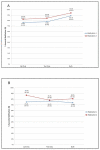Improving sexually transmitted infection results notification via mobile phone technology
- PMID: 24962503
- PMCID: PMC4209334
- DOI: 10.1016/j.jadohealth.2014.05.004
Improving sexually transmitted infection results notification via mobile phone technology
Abstract
Purpose: To improve adolescent notification of positive sexually transmitted infection (STI) tests using mobile phone technology and STI information cards.
Methods: A randomized intervention among 14- to 21-year olds in a pediatric emergency department (PED). A 2 × 3 factorial design with replication was used to evaluate the effectiveness of six combinations of two factors on the proportion of STI-positive adolescents notified within 7 days of testing. Independent factors included method of notification (call, text message, or call + text message) and provision of an STI information card with or without a phone number to obtain results. Covariates for logistic regression included age, empiric STI treatment, days until first attempted notification, and documentation of confidential phone number.
Results: Approximately half of the 383 females and 201 males enrolled were ≥18 years of age. Texting only or type of card was not significantly associated with patient notification rates, and there was no significant interaction between card and notification method. For females, successful notification was significantly greater for call + text message (odds ratio, 3.2; 95% confidence interval, 1.4-6.9), and documenting a confidential phone number was independently associated with successful notification (odds ratio, 3.6; 95% confidence interval, 1.7-7.5). We found no significant predictors of successful notification for males. Of patients with a documented confidential phone number who received a call + text message, 94% of females and 83% of males were successfully notified.
Conclusions: Obtaining a confidential phone number and using call + text message improved STI notification rates among female but not male adolescents in a pediatric emergency department.
Keywords: Adolescents; Emergency medicine; Healthcare quality improvement; Sexually transmitted disease; Text messaging.
Copyright © 2014 Society for Adolescent Health and Medicine. All rights reserved.
Figures



References
-
- Centers for Disease Control and Prevention (CDC) [Accessed April 21, 2014];Sexually Transmitted Diseases Surveillance. 2012 Available at: http://www.cdc.gov/std/stats12/default.htm.
-
- Goyal M, Hayes K, Mollen C. Sexually transmitted infection prevalence in symptomatic adolescent emergency department patients. Pediatr Emerg Care. 2012;28:1280. DOI:10.1097/PEC.0b013e3182767d7c. - PubMed
-
- Crosby RA, DiClemente RJ, Wingood GM, et al. Associations between sexually transmitted disease diagnosis and subsequent sexual risk and sexually transmitted disease incidence among adolescents. Sex Transm Dis. 2004;31:205–208. DOI:00007435-200404000-00002 [pii] - PubMed
Publication types
MeSH terms
Grants and funding
LinkOut - more resources
Full Text Sources
Other Literature Sources
Medical
Miscellaneous

